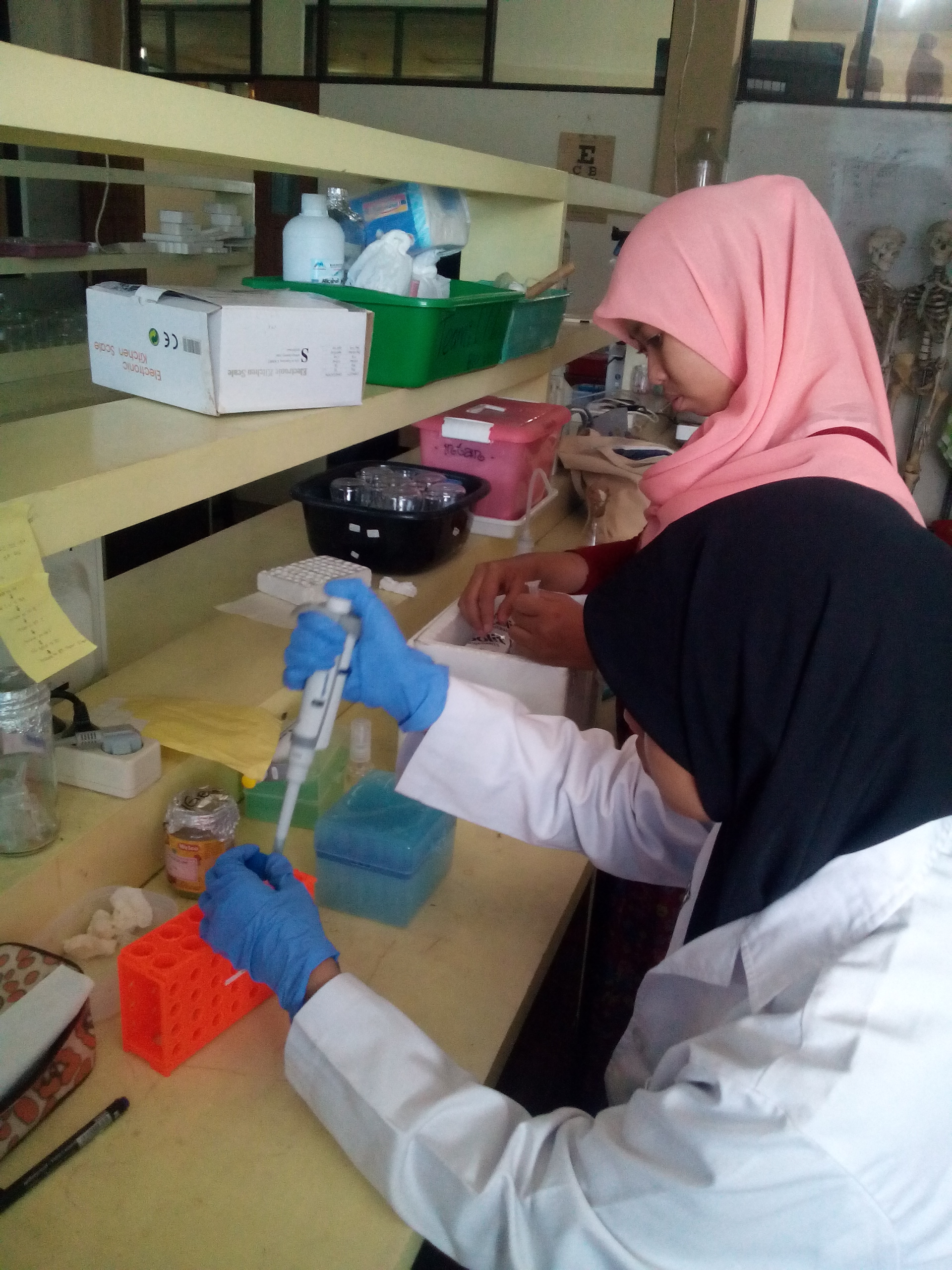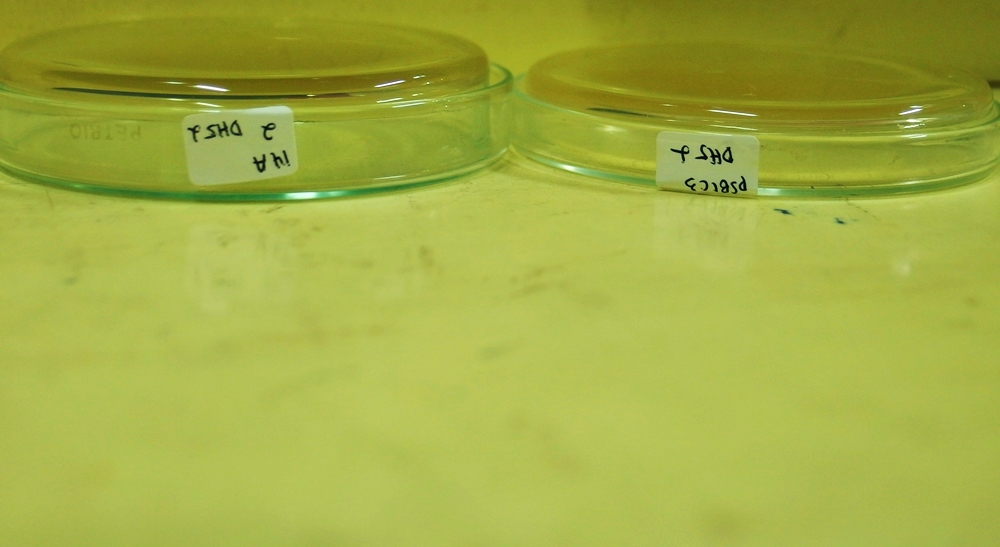Team:UB Indonesia
From 2014.igem.org
(Difference between revisions)
| Line 130: | Line 130: | ||
<div id="preventing" style="display:none;width:700px;"> | <div id="preventing" style="display:none;width:700px;"> | ||
<h2><center>Prevent is Better than Cure</center></h2> | <h2><center>Prevent is Better than Cure</center></h2> | ||
| - | <p align="justify">Indonesia is an agricultural country that most of their society works as farmer | + | <p align="justify">Indonesia is an agricultural country that most of their society works as farmer. Malang is resite at 440-667 (mdpl) altitude, one of the tourist destinations in East Java because of the potential of natural and climatic owned. Malang climate conditions during 2008 temperatures recorded ranging from 22.7 ° C to 25.1 ° C. While the maximum temperature reached 32.7 ° C and minimum temperature of 18.4 ° C. The average air humidity range 79% - 86%. With a maximum moisture content of 99% and a minimum at 40%. These conditions favor the development of the tea plant (Camellia sinensis).</p> <br> |
| - | <center><img src="https://static.igem.org/mediawiki/2014/e/ed/UB-Tea.PNG" width="" height=""></center><br> | + | <center><img src="https://static.igem.org/mediawiki/2014/e/ed/UB-Tea.PNG" width="" height=""><br> |
| + | Figure 1. Tea Plantation in Lawang, Malang City (Department of Electrical Engineering Brawijaya University, 2014)</center><br> | ||
| - | Tea extract contain EGCG used as the most effective antioxidant to against cervical cancer. But, levels of EGCG (Epigallocathecin gallate) in tea is very slightly. So, we will increase the level of this EGCG compound using siRNA to knockdown gene non-EGCG with expectation it will produce high yield of antioxidant. The applications are for supplement or feminine hygiene.<br><br> | + | <p align="justify">Tea extract contain EGCG used as the most effective antioxidant to against cervical cancer. Epigallocatechin-3-gallate (EGCG) is a polyphenol constituent present in green tea to inhibit cancer growth and the effects of EGCG is a potential anti-proliferative and pro-apoptotic agent in the human ovarian cancer line.But, levels of EGCG (Epigallocathecin gallate) in tea is very slightly. So, we will increase the level of this EGCG compound using siRNA to knockdown gene non-EGCG with expectation it will produce high yield of antioxidant. The applications are for supplement or feminine hygiene.</p> <br> |
| + | <center><table border="1" align="center"> | ||
| + | <tr> | ||
| + | <td><img src="" width="" height=""><br>Figure 2. EGCG structure 2D (National Center for Biotechnology Information, 2005)</td> | ||
| + | <td><img src="" width="" height=""><br>Figure 3. EGCG structure 3D (National Center for Biotechnology Information, 2005)</td> | ||
| + | </tr> | ||
| + | </table> | ||
| + | </center> | ||
| + | <br><br> | ||
| + | |||
| + | <p align="justify">Tea plant (Camelia sinensis) has catechin compounds that contains antioxidants. Catechin family that most effective used as antioxidant is Epigallocathecin gallate (EGCG). Based on research in vitro and in silico, EGCG is able to inhibit the proliferation of cancer cells with stop over-expression between L1 HPV 16- EGFR (Epithel Growth Factor Receptor) bond but there are few of EGCG content in tea plant. Based on these problems, we would to over- expression EGCG by knockdown non-compound EGCG gene, so hopefully the content of EGCG on tea are more prominent.<br><br> | ||
| + | |||
| + | <b>Our Design</b><br> | ||
| + | EGCG is able to inhibit the proliferation of cancer cells (Cornelia, 2013) because stop over-expression between L1 HPV 16- EGFR (Epithel Growth Factor Receptor) bond but there are few of EGCG content in tea plant. Based on these problems, we would to over- expression EGCG by knockdown non-compound EGCG gene, so hopefully the content of EGCG on tea are more prominent.<br><br> | ||
| + | |||
| + | We design siRNA sequence from LAR gene (to inhibit non-EGCG compound) using bioinformatics tool to initiate expression in mammalian cell (using HeLa cell). That part will be insert into the pSB1C3 linear backbone. To checking performance of this part, should be react with sequence target of siRNA LAR into the plasmid pSB1C3. We also prepare for positive control containing siRNA for GFP, insert into pSB1C3. Each part will be growth in HeLa cell culture and observed the succeding by fluorescent microscope.<br><br> | ||
| + | |||
| + | In this experiment, we design 2 part of biobrick:<br> | ||
| + | 1. siRNA LAR (Bba_K1367004) gene insert in pSB1C3 plasmid backbone (plasmid A)<br> | ||
| + | 2. siRNA GFP (Bba_K1367005) gene insert in pSB1C3 plasmid backbone (plasmid B)<br><br> | ||
| + | |||
| + | Plasmid A: | ||
| + | </p><br> | ||
| + | <center><img src="" width="700px" height="400"><br> | ||
| + | Figure 4 Construct design siRNA LAR BBa_K1367004 inserted in pSB1C3<br><br> | ||
| + | </center> | ||
| + | <p align="left"> | ||
| + | Plasmid A: | ||
| + | </p><br> | ||
| + | <center><img src="" width="700px" height="400"><br> | ||
| + | Figure 5. Construct design siRNA GFP BBa_K1367005 inserted in pSB1C3<br><br> | ||
| + | </center> | ||
| + | |||
| + | <p align="justify"> | ||
| + | References:<br> | ||
| + | Cornelia, Braicu, Gherman CD, Irimie A and Berindan-Neagoe I. 2013. Epigallocatechin-3-Gallate (EGCG) inhibits cell proliferation and migratory behaviour of triple negative breast cancer cells. J Nanosci Nanotechnol. Jan;13(1):632-7.<br> | ||
| + | Department of Electrical Engineering Brawijaya University. 2014. Tourism in Malang. http://eeccis.ub.ac.id/. Access at 10 October 2014<br> | ||
| + | National Center for Biotechnology Information. 2005. epigallocatechin gallate. http://pubchem.ncbi.nlm.nih.gov. Access at 10 October 2014. | ||
| - | |||
</p> | </p> | ||
</div> | </div> | ||
| Line 415: | Line 452: | ||
<li>Mix well and spin down.</li> | <li>Mix well and spin down.</li> | ||
<li>Incubate the restriction digest at 37˚C for 30minutes, and then 80˚C for 20minutes.</li> | <li>Incubate the restriction digest at 37˚C for 30minutes, and then 80˚C for 20minutes.</li> | ||
| + | <li>Arranges sequence of P97 and P105 then combined with restriction enzyme sequence (EcoRI and Xbal). Order the synthetic sequence into IDT (Integrated DNA Technology). </li> | ||
| + | <li>Getting P97 and P105 synthetic sequence from IDT. </li> | ||
| + | <li>Ligase the P97 and P105 synthetic sequence into PJET plasmid vector. Each plasmid vector ligase with P97 sequence or P105 sequence. Cloned. </li> | ||
| + | <li>Digest the plasmid vector that contain of P97 and P105 synthetic sequence with restriction enzyme EcoRI and Xbal. Then, digest the PSB1C3 plasmid backbone with same restriction enzyme. </li> | ||
| + | <li>Confirm the digested P97 and P105 synthetic sequence and PSB1C3 plasmid backbone using electrophoresis. </li> | ||
| + | <li>The electrophoresis gel which contain of digested P97 and P105 synthetic sequence and PSB1C3 plasmid backbone, extraction using DNA extraction gel kit. </li> | ||
| + | <li>Ligase the P97 and P105 synthetic sequence with PSB1C3 plasmid backbone become reccombination plasmid. </li> | ||
| + | <li>Comfirm the reccombination plasmid using electrophoresis and cloned.</li> | ||
| + | |||
</ul><br> | </ul><br> | ||
<b>SiRNADigestion</b><br> | <b>SiRNADigestion</b><br> | ||
| Line 647: | Line 693: | ||
<p align="justify"> | <p align="justify"> | ||
Synthetic Biology (Synbio) can not stop on our generation, but must be passed on the generations below us. Therefore, we hold socialization Synbio to students high school in Malang, East Java, Indonesia. Our focus is opening their minds to the real world’s problem and things we can do through science and engineering. We presented it by video animation, power point and brochure. <br><br> | Synthetic Biology (Synbio) can not stop on our generation, but must be passed on the generations below us. Therefore, we hold socialization Synbio to students high school in Malang, East Java, Indonesia. Our focus is opening their minds to the real world’s problem and things we can do through science and engineering. We presented it by video animation, power point and brochure. <br><br> | ||
| - | We hold | + | We hold imagination classes, in which students were divided into groups and given the opportunity toimagine bio-machine that can solve the problems in the world. Wow! The results were shocking! They have wild imagination in implantingsynbio concept clearly and precisely. Well, although some ideas seem impossible, but hey, there is nothing impossible in science, isn’t it?<br><br> |
<b>BACKGROUND</b><br> | <b>BACKGROUND</b><br> | ||
Revision as of 08:50, 17 October 2014
 "
"




































